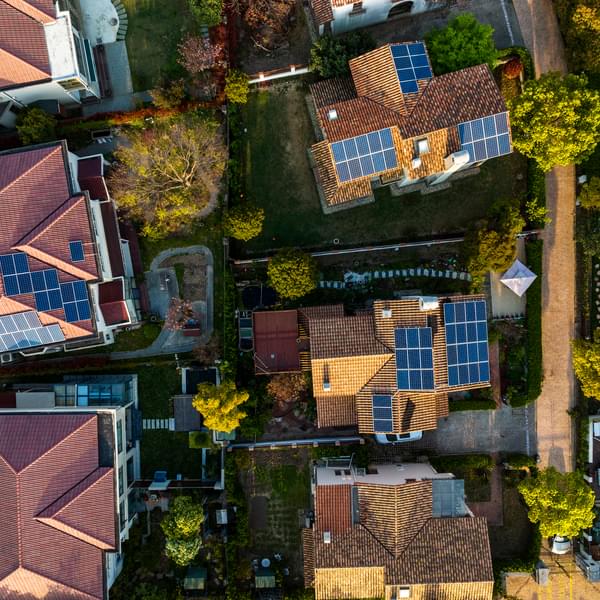Grid Edge Adoption Under the IRA
- Written by Charlotte Venner
- April 30, 2024

Recent events have upended the historical norm for electricity markets.[1]
Converging advances in what is called grid edge technology, along with the Inflation Reduction Act (IRA), have set the scene for major shifts in how utilities produce and distribute energy, as well as how customers consume energy. With climate change top of mind for many, utilities stand to benefit in more ways than one from the combined power of the IRA and grid edge adoption.
A New Kind of Grid
The term “grid edge” refers to a group of technologies, solutions, and innovations that are helping to transform the electric grid, bringing energy production and distribution closer to consumers.
The historic electricity market was centralized, fossil fuel-dependent, and powered by one-way energy transactions.[2] Now, energy consumers are often energy producers (thanks to technology like solar panels), and new advances have changed the way energy is produced and distributed, allowing those customers more independence from the traditional grid.[3]
Responding to these changes, grid edge innovations across infrastructure, network, application, and analytics are decentralizing the electrical grid and making it easier for utilities to decarbonize.[4] As the landscape of the electrical grid evolves, the IRA is offering key enticements to support these grid edge innovations.
Empowered by the IRA
With its passage in 2022, the Inflation Reduction Act became one of the largest ever public investments in the energy sector.[5][6] To meet an ambitious goal of cutting greenhouse gas emissions to about 40% below 2005 levels by 2030, the IRA is leaning heavily on the technology and behavior that grid edge supports.[7]
For example, electric vehicle (EV) usage is essential to reducing emissions and represents a new trend in energy consumption. The IRA extends a 30% investment tax credit for EV charging through 2032, including credits for multiple chargers per site. This opens the incentive to operations like public charging stations and workplaces, and utilities can expect major growth in charging infrastructure both large and small-scale.[8]
Home electrification is another area supported by the IRA, which offers up to $14,000 in rebates for homeowners to electrify their homes. Other programs like Solar for All will create new or expand existing income-eligible solar programs, which will enable over 900,000 qualifying households to benefit from distributed solar energy. These large national initiatives are likely to spur further investments in customer-generated electricity, as more people upgrade their homes with energy efficiency and electrification improvements.
Taken together, the IRA incentives represent enough of a boost that experts anticipate clean energy making up 81% of all American electricity by 2030.[9] The IRA is full of incentives and investment toward distributed energy resources (DERs) like small-scale solar, EVs, smart appliances, and battery storage — precisely the kind of technology the traditional grid was not built to support.[10] Research predicts the DERs market in the U.S. to double between 2022 and 2027.[11]
Considering this, how can utilities keep up with transformations to the grid?
The Promise of Grid Edge for Utilities
Decentralization of the electrical grid can help utilities respond to an increased DERs market.
Grid edge helps streamline clean energy production using “behind-the-meter” (BTM) resources. As the IRA increases the amount of customer-generated energy, BTM resources like home solar panels, small wind turbines, or microgrids will help utilities respond to price signals and manage their resources, maintaining connection without centralization.[12] Research suggests BTM capacity will increase 3.7 more times between 2022 and 2027 than in the previous five years.[13]
Grid edge software can be crucial to utilities distributing energy to a decentralized grid, and customers consuming that energy. Distribution planning systems, real-time grid optimization, and price-responsive demand response are all software tools available to utilities to manage a new kind of energy distribution and consumption.[14]
Grid edge also provides analysis services to help utilities stay up-to-date on developments in grid structure and energy consumption.[15] Topical market reports and insights identify new trends, deployment strategies, policy, and products for utilities, while a data hub collects and visualizes data points across grid infrastructure and customer and utility revenue.[16]
Equity and the Climate Crisis
When grid edge technologies and resources are equitably distributed to create a stable, functioning, decentralized grid, individuals are granted more control over their energy use and greenhouse gas emissions. This independence supports equitable access to energy, while contributing to the IRA’s large-scale effort to reduce greenhouse gas emissions. Together, the IRA and grid edge represent a promising combination of funds and insight to help utilities prepare for a new kind of electrical market.
[1] https://www.greentechmedia.com/articles/read/what-is-the-grid-edge
[2] https://www.greentechmedia.com/articles/read/what-is-the-grid-edge
[3] https://www.greentechmedia.com/articles/read/what-is-the-grid-edge
[4] https://www.woodmac.com/market-insights/topics/the-grid-edge/
[5] https://www.woodmac.com/news/opinion/us-inflation-reduction-act-set-to-make-climate-history/
[6] https://energywebx.medium.com/the-inflation-reduction-act-super-charged-the-energy-transition-but-the-grid-isnt-ready-deaab267a078
[7] https://www.utilitydive.com/news/how-utilities-can-prepare-for-inflation-reduction-act-impacts-via-bipartisa/642226/
[8] https://www.woodmac.com/news/opinion/inflation-reduction-act-tailwinds-and-other-tales-from-the-grid-edge/
[9] https://www.energy.gov/sites/default/files/2023-03/Power-Sector%20Transitions%20Fact%20Sheet.pdf
[10] https://energywebx.medium.com/the-inflation-reduction-act-super-charged-the-energy-transition-but-the-grid-isnt-ready-deaab267a078
[11] https://www.woodmac.com/news/opinion/transformation-distributed-energy-resource-market/
[12] https://www.woodmac.com/market-insights/topics/the-grid-edge/
[13] https://www.woodmac.com/news/opinion/transformation-distributed-energy-resource-market/
[14] https://www.ase.org/blog/so-what-exactly-grid-edge-thing-anyway#:~:text=Grid%20edge%20software%20includes%20automated,on%20modernizing%20utility%20interconnection%2C%20planning%2C
[15] https://www.woodmac.com/industry/power-and-renewables/grid-edge-service/
[16] https://www.woodmac.com/industry/power-and-renewables/grid-edge-service/
Related Energy Resources
Explore Resource Innovations' energy management insights.